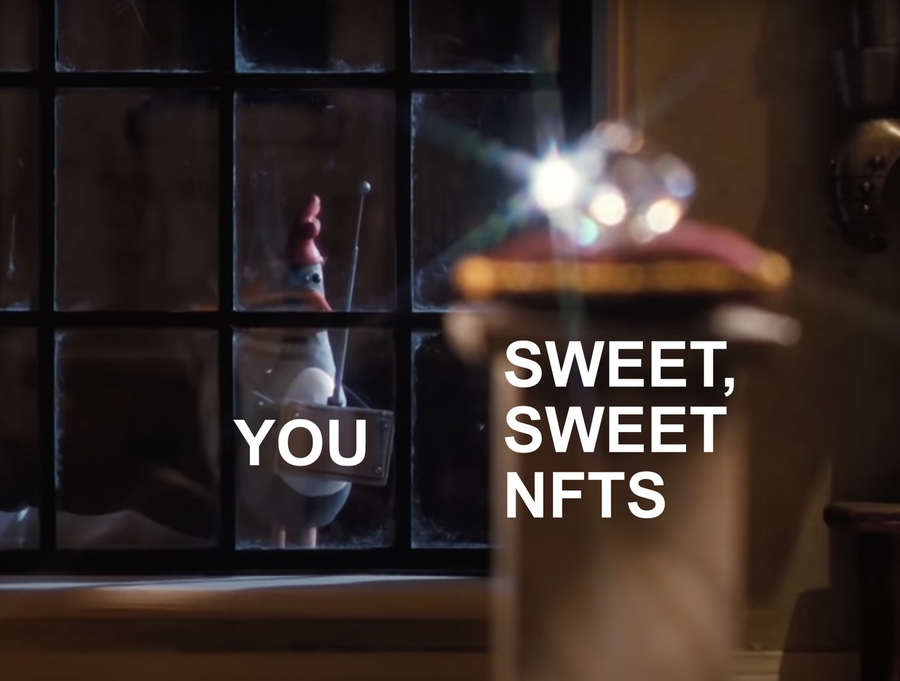Case Study
So do people really think this will be the future of collecting?
Many people really hope so — like whoever paid almost $390,000 for a 50-second video by Grimes, or the person who paid $6.6 million for a video by Beeple. Actually, one of Beeple’s pieces was auctioned at Christie’s, the famou—

Sorry, I was busy right-clicking on that Beeple video and downloading the same file the person paid millions of dollars for.
Wow, rude. But yeah, that’s the awkward bit. You can copy a digital file as many times as you want, including the art that’s included with an NFT.
But NFTs are designed to give you something that can’t be copied: ownership of the work (though the artist can still retain the copyright and reproduction rights, just like with physical artwork). To put it in terms of physical art collecting: anyone can buy a Monet print. But only one person can own the original.
No shade to Beeple, but the video isn’t really a Monet.
What do you think of the $3,600 Gucci Ghost? Also, you didn’t let me finish earlier. That image that Beeple was auctioning off at Christie’s ended up selling for $69 million, which, by the way, is $15 million more than Monet’s painting Nymphéas sold for in 2014.

Whoever got that Monet can actually appreciate it as a physical object. With digital art, a copy is literally as good as the original.
So every NFT is unique?
In the boring, technical sense that every NFT is a unique token on the blockchain. But while it could be like a van Gogh, where there’s only one definitive actual version, it could also be like a trading card, where there are 50 or hundreds of numbered copies of the same artwork.
Oh no, you’re about to talk about the apes aren’t you?
Sure am!
If you haven’t heard about the Bored Ape Yacht Club, it’s one of the most successful NFT projects, with apes (which are procedurally generated and have unique characteristics) selling for millions of dollars. The company behind the series of NFTs has created a spin-off cryptocurrency, broken the blockchain for a few hours with how popular one of their sales was, and even acquired other massive NFT brands. And a reminder: this all happened because people really like saying that they own a picture of a Bored Ape.
People like, for instance, Jimmy Fallon and Paris Hilton, who discussed their apes on TV in a clip that went viral.
This kind of exclusive club isn’t really a new phenomenon — people have long built communities based on things they own, and now it’s happening with NFTs. It could be argued that one of the earliest NFT projects, CryptoPunks, got big thanks to its community.
I’ve heard there were kittens involved. Tell me about the kittens.
NFTs really became technically possible when the Ethereum blockchain added support for them as part of a new standard. Of course, one of the first uses was a game called CryptoKitties that allowed users to trade and sell virtual kittens. Thank you, internet.
I love kittens.
Not as much as the person who paid over $170,000 for one.

At one point, people thought that the kittens would be used in games in somewhat interesting ways. However, that glimmer of hope has been decimated by the fact that almost every salesperson in the NFT space promises that their tokens will be part of a game or metaverse.
When real game developers like Ubisoft and the studio behind STALKER have said they’d integrate NFTs into their games... people reacted VERY negatively. The companies have either had to scrap their plans entirely or severely tone down the amount of blockchain stuff in their games.
Of course, there have been a few fun experiments in the NFT space (though I’ll admit that at least one of them was poking fun at the concept of NFTs), but... listen, one of the most successful NFT-based games is kind of a weird version of feudalism, and also got mega-hacked. So there’s that.
Could I pull off a museum heist to steal NFTs?

This image is not an NFT. Yet. Image: Wallace and Gromit: The Wrong Trousers
That depends. Part of the allure of blockchain is that it stores a record of each time a transaction takes place, making it harder to steal and flip than, say, a painting hanging in a museum.
Or at least that’s the theory. In reality, many, many people have gotten their NFTs stolen by attackers using a variety of tactics. To be clear, hackers aren’t always playing 5D chess here. For the ever complicated hack of the programs that control the flow of crypto, there’s a case: '$1.7 million in NFTs stolen in apparent phishing attack on OpenSea users' where someone was tricked into signing a transaction they shouldn’t have through run-of-the-mill phishing.
Okay, so what’s that you said about pirating?
So someone created this site called The NFT Bay as a sort of art project, where they put up a torrent pointing to a 19TB ZIP file, which they said included every NFT on the Ethereum and Solana blockchains. There’s some doubt about whether was actually a treasure trove of NFTs (if such a thing could be referred to as "treasure"), but in theory, it’s actually possible to scan the blockchain to find every record of an NFT being minted and download the media it links to.
Real or not, it was an incredible piece of performance art, sparking a conversation (closer to a flame war) about the right-clicker mindset.
Sorry, what on Earth is a right-clicker mindset?
Ah, sorry. 'Right clicker' is sort of a joking derisive term used by NFT boosters to deride people who just don’t get it. The thought is that you’re completely missing the point if you think that just downloading (or pirating) a JPEG will actually get you the valuable part of an NFT.

Last updated